Rope can be invaluable took but finding the right rope that meets your needs can be overwhelming. This is because there are many different types of ropes with unique characteristics like weight, strength, and durability.
Some ropes are stronger and more durable. Some are better suited for indoor use. Some have a soft texture etc. Picking the right type of rope for your project starts with figuring out which material is the right fit for the job.
In this guide, we will take a look at the different types of rope material, how they are constructed and their best uses so you can decide which one is right for your situation.

Source: Pexels
Rope bulk material by type
Rope materials can generally be classified into three groups based on type – natural, synthetic, and metal. The material used in making natural rope is sourced from environmentally-friendly products and doesn’t involve the use of chemicals in the manufacturing process. Examples of natural ropes include cotton, manila, jute, and sisal.
Synthetic rope, on the other hand, is made from materials that are not of natural origins such as nylon, polyester, and polypropylene. These synthetic ropes are usually long-lasting than natural ropes, which explains why are in high demand.
Metal rope generally refers to wire rope. Wire rope is the mechanical properties and geometric size of the wire in accordance with certain rules twisted together in a spiral wire bundle, wire rope by the wire, rope core, and grease composition.
Cotton rope
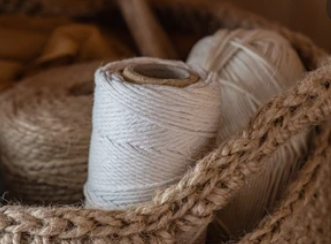
Derived from the seed of the cotton plant, cotton rope is an extremely popular rope material. Because the fibers are generally softer, they provide a soft feel and are very lightweight, which means you can conveniently take them with you wherever you go.
Provided it’s not exposed to harsh conditions, the cotton rope can last a long time. It’s particularly suitable for indoor use or warmer climates. Cotton rope is used for pet toys, crafting and macramé, constructing hammocks, gardening, jewelry, and several other applications.
Manila rope
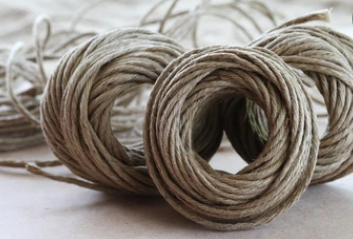
Also referred to as Manila hemp rope, Manila is a fiber procured from the abaca tree leaves native to the Philippines and other parts of Southeast Asia. It is a general-purpose rope because of its versatility. You can use it for both indoor and external missions such as decoration, landscaping, décor, farm work, exercise, fish nets, etc.
Like other natural rope materials, water is not the best friend to this rope as it may become damaged. Also, the rope shrinks when wet and you may be unable to remove any knot you have tied. On the positive side, Manila rope is highly rated in terms of durability and resistance to saltwater damage and some level of UV damage.
Sisal rope
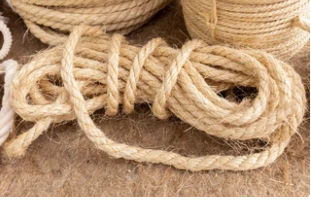
If you’ve ever bought some twine, you probably have an idea of the characteristics of sisal. It is a coarse, strong, durable fiber that is resistant to moisture and deterioration from weather and saltwater. It is sourced from the agave Sisalana plant and the fibers are completely free from chemical and oil treatments, making them safe for applications like farming, pets, livestock, craft beer brewing, etc.
If you are looking for a lighter rope strand for your suspension-related, sailing, or water sports use, sisal rope may not be right for your situation as it has high water absorption, poor shock absorption, and inability to float.
Jute rope

Another natural fiber rope, jute is a versatile rope that can be used for almost everything including small arts, and crafts projects, gardening, and all-weather applications. Despite having a small diameter, this rope product is remarkably strong and offers little stretch while being both biodegradable and compostable.
Many people love this rope because of its coarse appearance which gives it a rugged look. However, jute rope is not highly water resistant, so be sure to dry it stretched out and under tension otherwise, it will shrink. Additionally, if your situation requires a rope material that can bear heavy weights, jute rope might not be right for you.
Nylon rope

Nylon is a rope synonymous with high strength. When you need a rope that is capable of shock absorption, natural elongation, and resistance to abrasion, sunlight, and chemicals, nylon rope is your best bet. All these characteristics make nylon rope suitable for both indoor and outdoor use.
Made from a silky thermostatic strand, this rope keeps a smooth surface and has a bit of stretch, which makes it a good rope to use for dynamic climbing purposes. If you’re planning to use a nylon rope for your mission, be sure to keep it from getting wet as water can make it stiff and unmanageable.
Polypropylene rope

Polypropylene is another versatile synthetic rope material. It is made from a thermoplastic material and is capable of withstanding use in harsh conditions including UV rays, water, chemicals, road salts, and more. Another notable feature of this rope is that it is dielectric, which means it does not conduct electricity.
Because of its lightweight nature, this synthetic rope floats on water, making it suitable for use in water sports like waterskiing. It doesn’t splinter easily and can improve visibility in low light or harsh weather conditions. It also comes in different sizes and bright colors.
Polyethylene rope
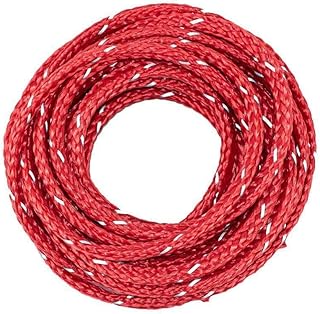
This rope material is similar to polypropylene but slicker with better abrasion resistance as well as better resistance to heat. It is also lightweight and can float on water while withstanding tough conditions like water and chemical wear. That explains why it’s commonly used to make nets and for other applications in the fishing industry. It is also used in camping and construction activities.
Polyethylene ropes are also resistant to UV rays, so you can use them in the sun for hours at length. Although they offer some decent resistance to heat, high-heat environments may soften and weaken the plastic fibers.
Polyester rope

Polyester rope is widely regarded as an “all-purpose” rope because it handles virtually anything you throw at it. Compared to other types of ropes, polyester is resistant to rot, decay, oil, chemical-based weakening moisture, UV damage, heat, and grease. It is a tough heavy-duty rope known for high breaking strength.
A unique characteristic of this rope material is that it tends to be torque and stretch-free. It also does not shrink after getting wet, so you should have no problem untying knots. Frequently used in marine environments, polyester ropes are a great choice if you’re looking for an option that offers great strength and that’s less likely to compromise its integrity over time.
To learn more, you can refer to this article: What is a Polyester Rope?
Types of rope by style
Ropes are also categorized based on how they are constructed. Rope construction further narrows down the suitability of rope materials for specific applications. Here are some of the styles the rope materials listed above are available in.
Single braid rope
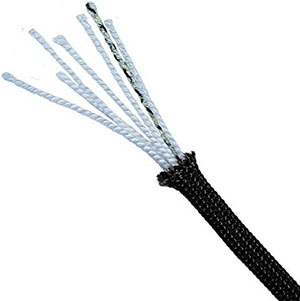
This rope consists of 8-12 strands of synthetic material braided together. They also have a lock-stitch construction to ensure the rope’s durability and so it does not fray easily. It’s best for sailing, camping, and other outdoor applications.
Plaited rope
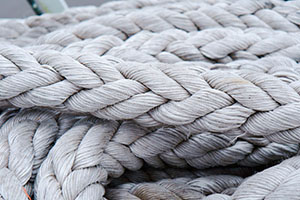
A plaited rope consists of four different sets of strands intertwined and woven with one another, wrapping around the rope’s core. It is also referred to as a square braid because it’s not as round as the twisted rope and can feel coarse on the hand. Plaited ropes are easy to knot and handle.
Twisted rope
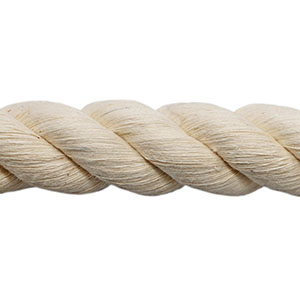
Also called laid rope, the twisted rope is made by coiling three strands together in the same direction but the fibers in each strand are twisted in opposite directions. It is a stiff rope style and can get kinked if not handled carefully. It’s great for decorative, exercise climbing, and gym equipment applications.
Double braided rope
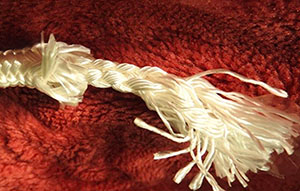
A double-braid rope features a braided core and a braided rope that’s wrapped around it. It essentially consists of two single-braid ropes intertwined together for ultimate strength. A double-braid rope is perfect for marine use but not for manufacturing purposes.
Hollow braid rope
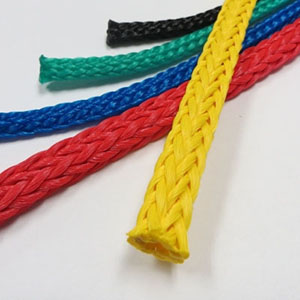
Hollow braids have a hollow center, which means you can quickly and easily splice them. They are lightweight and easy to handle. They are well-suited for nautical settings as well as for wet environments as they are resistant to water damage, making them easy to manipulate.
Diamond braid rope
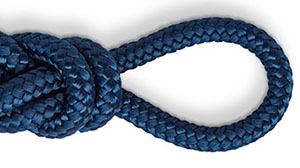
Also known as diamond rope, Diamond braid ropes are among the strongest type of ropes by construction, which makes them quite expensive too. This is because they are made by binding rope tightly around an inner fiber core, resulting in a rope that’s firm and capable of withstanding harsh use without being damaged or breaking. A significant advantage of this rope is that it can easily be spliced, making it easy to work with.
Solid braided rope

These rope products are a great choice for tying down anything from boats and trailers to cargo containers. They are strong, durable, and resistant to rot which is why they make excellent high-load tie-downs.
Conclusion
No matter the type of project you have at hand, there are rope products that can meet your requirements. Now that you have a good understanding of the different types of rope products, you can make your choice based on their strength, weight, biodegradability, and other factors. But if you’re struggling or having any questions about rope supplies, don’t hesitate to contact us and we will guide you to choosing the best quality product.

